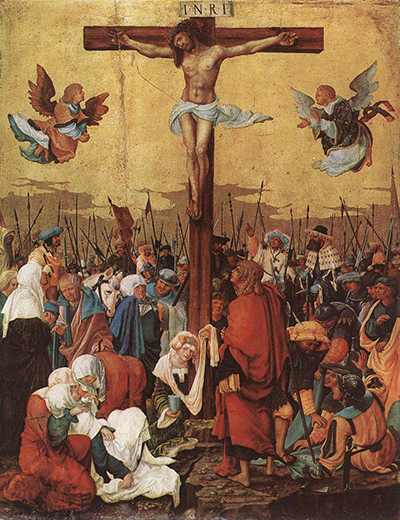Christ on the Cross continues the artist's concentration on religious themes which was common in some periods of his career.
Whilst Altdorfer liked to work with landscapes, he would take on other genres in order to make him a commercially successful artist, with regular commissions avaiable for those able to complete religious scenes effectively, as well as portraits.
Description
The format of Altdorfer's Christ on the Cross is entirely typical of the period, with angels floating either side of Christ at the top of the painting, whilst other figures are included in the lower half. The yellow sky behind is left fairly blank, and sets a unique mood as compared to the other artist's work.
The yellow sky is very unusual for this artist, where normally he would prefer a more positive blue sky. Perhaps he deemed that inappropriate for what is such a powerful but unfortunate scene. He plies the scene with many figures who had to the energy and desperation of the scene, a topic used so frequently during the Renaissance and also Baroque art movements.
Christ's head leans to our left hand side, though there is none of the injuries which are displayed in other interpretations by the same artist. Christ's modesty is covered by a cloth around his waist which flutters in the wind. He is also lofted up fairly high in comparison to other depictions of the cross, which is perhaps a method of arranging the painting, as well as distancing him visually and symbolically from his supporters.
Beneath Christ, we find an unusually large number of figures gathered. Long weapons indicate the presence of soldiers, whilst closer to us we see the suffering of Christ's friends, some of whom are devastated to the point of collapsing on the floor. Some lettering has been added above Christ's head, to represent the scene, and it is noticeable here how Altdorfer chooses not to include any of his landcape details which tended to find their way into almost all of his paintings.
Painting Details
Albrecht Altdorfer's Christ on the Cross was completed in circa 1520 and is now part of the permanent collection of the Budapest Museum of Fine Arts in Budapest, Hungary. It measures 75 x 57.5 cm and is just one of many Christ on the Cross paintings, drawings and etchings produced by the artist across his career, each of which varied in mood and layout.
Levels of Artistic Expression
Many of the commissions that he did receive would require Christian stories for display in wealthy institutions. They allowed him a certain level of autonomy, so long as the content was produced faithfully and respectfully. It became hard for the artist to make use of his skills in landscape painting and he would simply have to accept things as they were before getting an opportunity to do precisely as he wished at a later date.
Adapting to the Market
Art history is full to the brim of similar examples to that where artists have struggled to find a balance between exploring their creative ideas freely but also managing to finance their daily lives too. Etchings were used by some Renaissance artists, including Albrecht Altdorfer, in order to quickly cover the financial necessities of life through large scale reproductions that could be sold on cheaply and in great numbers.




